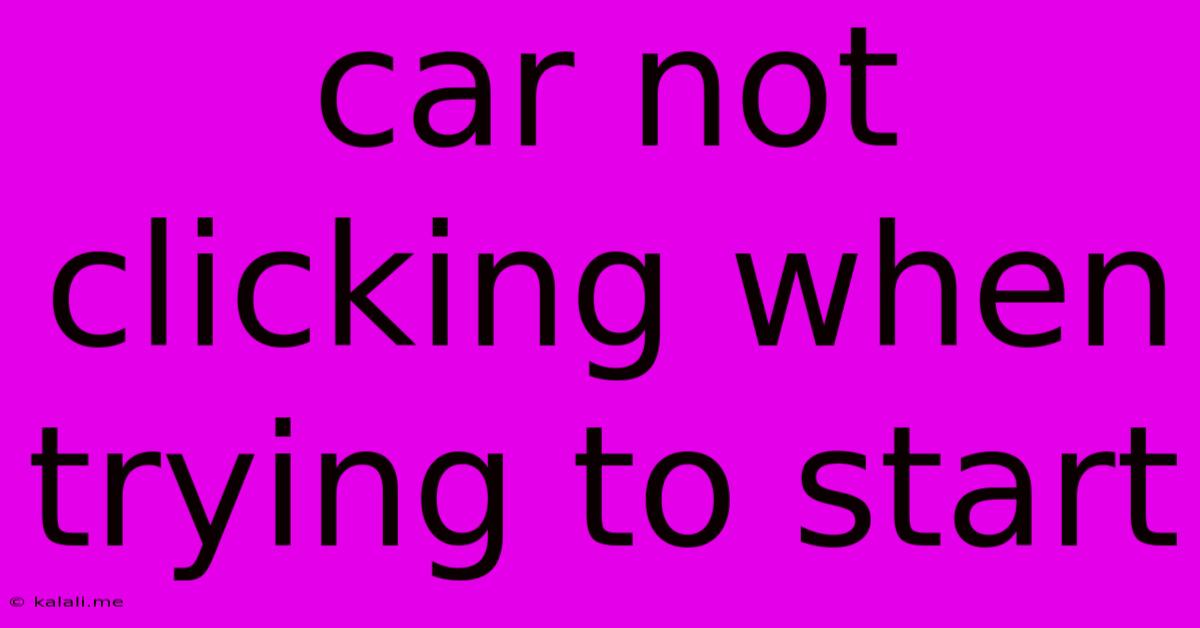Car Not Clicking When Trying To Start
Kalali
May 28, 2025 · 3 min read

Table of Contents
Car Not Clicking When Trying to Start: Troubleshooting Guide
Your car's refusal to start can be frustrating, especially when you're in a hurry. A "no click" scenario, meaning you turn the key and hear nothing but silence instead of the usual engine cranking sound, often points to a problem with the electrical system. This comprehensive guide will help you diagnose the issue and potentially get your car running again. This article covers common causes, troubleshooting steps, and when to call a professional.
Understanding the "No Click" Problem
When you turn your car key (or press the start button), the starter motor is supposed to engage, creating that familiar clicking sound as it tries to turn the engine over. If you hear nothing at all, it means the starter motor isn't even receiving power. This is different from a slow cranking sound, which usually suggests a low battery or other issues. This article focuses specifically on the complete absence of a click.
Common Causes of a "No Click" Start
Several factors can cause this frustrating problem. Let's examine the most common culprits:
1. Dead Battery
This is the most frequent cause. A completely discharged battery won't have enough power to even activate the starter solenoid, resulting in the dreaded silence.
- Troubleshooting: Try jump-starting your car. If it starts, you've confirmed a dead battery. You'll need to charge or replace the battery. Check the battery terminals for corrosion; clean them if necessary.
2. Faulty Battery Cables
Corroded, loose, or damaged battery cables can prevent sufficient power from reaching the starter motor.
- Troubleshooting: Visually inspect the cables connecting the battery to the car's electrical system. Look for any signs of damage, corrosion, or looseness. Clean or replace the cables as needed.
3. Faulty Starter Motor
The starter motor itself could be malfunctioning. This is a more serious issue requiring professional attention.
- Troubleshooting: While you can't easily test this at home, the absence of any click strongly suggests the starter motor or its solenoid could be the problem.
4. Faulty Ignition Switch
The ignition switch is responsible for sending power to the starter motor. A broken or worn-out ignition switch will prevent power from reaching the starter.
- Troubleshooting: This is harder to diagnose at home. A mechanic will usually need to test the circuit to pinpoint if this is the issue.
5. Blown Fuse or Relay
A blown fuse or a faulty relay in the starter circuit can also interrupt the power flow to the starter motor.
- Troubleshooting: Check your car's fuse box and relay panel (usually located under the hood or inside the cabin) for any blown fuses or damaged relays related to the starting system. Replace any faulty components. Refer to your car's owner's manual for the location and identification of these components.
6. Neutral Safety Switch (Automatic Transmission)
In automatic transmission vehicles, a neutral safety switch prevents the car from starting unless the gear selector is in Park or Neutral. A malfunctioning switch can prevent the car from starting.
- Troubleshooting: Make sure your car is in Park or Neutral. If the problem persists, the switch itself might be faulty and require replacement.
When to Call a Mechanic
If you've checked the battery, cables, fuses, and relays, and your car still won't start, it's time to call a professional mechanic. Issues with the starter motor, ignition switch, or neutral safety switch often require specialized tools and expertise for diagnosis and repair.
Preventative Measures
Regular battery maintenance, including periodic testing and cleaning of terminals, can significantly reduce the likelihood of encountering a no-click starting problem. Addressing any corrosion promptly can prevent more serious electrical issues.
This guide provides a starting point for troubleshooting your "no click" starting problem. Remember to always prioritize safety when working with car batteries and electrical systems. If you are unsure about any step, it's always best to seek professional assistance.
Latest Posts
Latest Posts
-
How Many Watts Does A Sander Use
May 30, 2025
-
What Does Nano Mean In Spanish
May 30, 2025
-
How Do I Fix A Leaky Roof
May 30, 2025
-
How Do You Clean Concrete Basement Floors
May 30, 2025
-
Unable To Add Document To Print Job
May 30, 2025
Related Post
Thank you for visiting our website which covers about Car Not Clicking When Trying To Start . We hope the information provided has been useful to you. Feel free to contact us if you have any questions or need further assistance. See you next time and don't miss to bookmark.